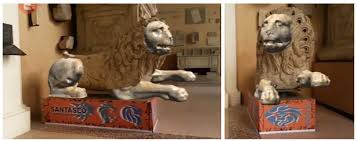https://iopscience.iop.org/article/10.1088/1757-899X/364/1/012018
This paper proposes the integration of photogrammetric reconstruction, 3D modelling and augmented reality application in order to achieve the complete visualization of a stone sculpture even if highly damaged or fragmentary. The first part of the research aims to the reconstruction of the original aspect of an incomplete sculpture, by using photogrammetry techniques based on standard resolution photos and free software in order to obtain a first model; then, we integrate this model with other 3D digital data (from other sculptures of the same period) or with 3D modelling based on historical sources and views from historians, aiming to achieve the original aspect of the sculpture. The second part of the research consists of the embedding of the obtained model in a custom application able to render in real-time the 3D reconstruction of the lion. Then, the rendering is overlaid to the video stream of the real scene and, as a result, a complete 3D digital model of the sculpture is achieved and could be visualized through a VR viewer. As a case study, we focus on a Roman stone sculpture of a male lion conserved in the Museo Estense of Modena (Italy), which lacks of its head and its four legs. The original aspect of the lion may be achieved by integrating the damaged sculpture with other photogrammetric reconstructions of lions sculptures of the same period and with 3D model based on historical sources. Finally, the lion is visualized through an augmented reality application which digitally overlays the reconstructed models on the original one.

